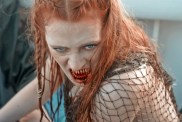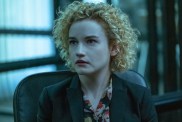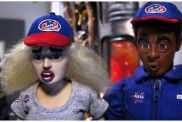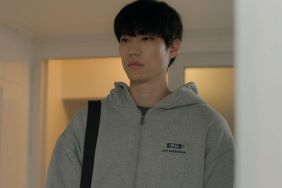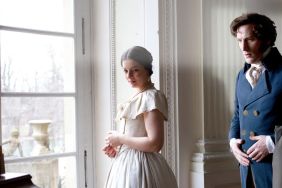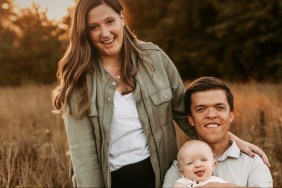There are few filmmakers who have had a more interesting career than that of Mexico’s Alfonso Cuarón, who hasn’t been the most prolific director over the past few years but whose every film is received with almost universal acclaim. His filmography has also shown an incredible amount of diversity, especially when he went from making a smaller indie film in Mexico with Y Tu Mama Tambien to directing the third chapter of the “Harry Potter” franchise, which he followed with the sci-fi thriller Children of Men.
That was about seven years ago, but now Cuaron is back with Gravity, a film that has Sandra Bullock stranded and struggling to survive in outer space for 90 minutes of the most incredible outer-space footage you’re likely to see anytime soon, as Cuaron and his team create the feeling of floating in zero gravity, an experience enhanced by the decision to film in 3D.
ComingSoon.net got on the phone with Cuarón for an extended interview following the film’s premiere at the Venice and Toronto Film Festivals, and as one might expect, a lot of our conversation involved us trying to figure out how Cuarón and his team created some of the film’s more amazing sequences.
ComingSoon.net: I hadn’t realized how long it’s been since the last time we spoke, so I went back and looked and I was shocked to learn it’s been six years since we talked for “Children of Men.”
Alfonso Cuarón: It’s been a while, yes. I was young and full of promise then.
CS: Oh I’m sure both things are still true. The movie’s great. I saw it at Toronto last week and probably the best compliment I can give you is that I wanted to see it again almost immediately afterwards, which is very rare.
Cuarón: Oh, thank you, Ed, that’s good to hear.
CS: I have a feeling I won’t be alone there. I have a feeling “Gravity” is one of those movies people will want to watch multiple times, because it’s like a good magic trick where you have no idea how it was done. Really amazing achievement.
Cuarón: Thank you. I’m glad it’s connecting. It was two and a half years where we didn’t know if this was going to work, so it’s great to actually experience the reaction of the people, because I have to say it was just an endless process in which for a big chunk of the project, we were not absolutely certain if the theory was going to work.
CS: I remember speaking to David Heyman about the movie – probably about four years ago. He didn’t say much about it, but I knew it was a very ambitious project and I know it’s been a challenge to make the movie, so what was the biggest hurdle you had to get over to start filming it?
Cuarón: The biggest challenge was gravity or lack of it. That’s the thing. Once you have a whole film that you’ve staged and choreographed in Zero G or microgravity, just to try and solve that and honor as much as we could the realities of physics in space, that whole thing just became the biggest challenge to work around.
CS: As you and Jonas were writing the script, did you have some idea how you would do some of those things as you were writing or was that not even an issue, you just wanted to write it?
Cuarón: No, it was a whole act of miscalculation. I have to say that we were writing the screenplay and we were not thinking about solutions of how we were going to shoot it. Actually, we were very precise about how we wanted it to look and to feel. Actually, when I finished the script, I sent it immediately to Chivo, Emmanuel Lubezki, the cinematographer, because he’s my oldest collaboration, and I said, “Hey Chivo, read the screenplay. It’s one movie, two characters, we can do it in and out very quickly.” I really thought it was going to require a fair amount of visual FX but it was going to be very straight-forward. When we started working on the project and testing, it very soon became clear that the present technology was not going to make it so we had to develop our own set of tools to do the film.

CS: Is that mainly because of the existing cameras? Did you always know you were going to shoot it in 3D?
Cuarón: Actually, the original title of the screenplay was “Gravity: A Space Suspense in 3D.” What we didn’t know was the whole technology to make people float, throughout the whole film in long continuous shots, because there’s certain conventional technologies or tools – you have rigs with wires and stuff but they have a lot of limitations. Part of the limitations of the wires is that one, it creates a lot of strain in the faces, and two is that pretty much you’re on one axis. If you’ve seen the film, our characters are always rolling and rolling in three different axes, so there’s no wire system that can do that. We were studying footage of people and objects in space and it was clear
that is the reason why when they do films in space, the mothership has a special button that creates the gravity in place so that they walk around the spaceship and then they go out to repair and it’s maybe a three or four minute scene max with a lot of cuts. The problem is when you have a whole film that’s in Zero G in continuous shots.
CS: I feel that plays a large part in the film’s authenticity, the fact that it does take place in Zero G the entire time and you really feel that with the actors and objects floating in space. While you guys were writing, did you have any NASA experts or anyone you could consult with while envisioning this?
Cuarón: Not during the first draft and once we had the first draft, we started involving experts and after the first draft we realized all the stupid things that we have described that would be completely implausible, so we had to do little rewrites based upon that. And then, throughout the process, we kept on having advisors, not only NASA and astronauts and other people that are experts in different fields, but also physicists, trying to explain to us how objects react in micro-gravity and zero resistance. That was probably the toughest innovation, because what happens in micro-gravity and zero resistance is completely counter-intuitive. Our brain is programmed to understand reality from the standpoint of our eyes and our weight and that’s exactly the things that doesn’t exist up there. Up there, there’s no up and there’s no down. There’s no horizon, there’s no weight, and not only that, but when objects interact, it’s a completely different thing, because there’s no resistance. If you throw a baseball, the ball keeps on going straight until the infinite or until some other object changes the course of the ball, but if you throw the ball, at the same time you’re pushed backwards. With the same intensity that you throw the ball you move backwards and on top of that, depending on the distribution of weight in your body, that’s how you roll and spin or don’t roll and spin. So it’s a lot of little minutia that we have to try to understand and learn and apply. It was particularly difficult for animators, because when you learn how to draw, you learn based on horizon and weight.
CS: You also have to get actors who are willing and able to do this and I’ve heard some of the stories about what Sandra went through to recreate this, so when you went out to actors with your script, how did you explain to them exactly what’s going to be involved with making this happen? I can’t imagine it’s that obvious when you read the screenplay how difficult it’s going to be recreate it in the studio.
Cuarón: The thing that happened with Sandra actually was that for a long time we were considering the “vomit comet.” I’m not sure if you’re familiar with parabolic flights. Basically, it’s an airplane that plummets for 25 seconds at a time. We were exploring that and for me that was a lot of fun and Sandra was terrified because she’s scared of flying because she had two very bad incidents in planes – serious ones, actually. She was willing to overcome her fears and act and do it, so when we told her that that wasn’t going to be the system and we have these other sets of tools, she didn’t care how painful the other tools were.
CS: You and Chivo probably spent a lot of time preparing to figure out how you were going to shoot it
Cuarón: Also with Tim Webber, the visual FX supervisor. He’s a big hero on this film.
CS: How was he involved early on? Was he doing a lot of pre-visualizations before you started shooting?
Cuarón: The weird thing of this film is that it’s the worst case scenario of animation and the worst case scenario of a live action, so in order to begin shooting, we basically had to already finish post-production of the animation. We had to animate the whole film but in full detail in terms of timing so that we can discuss the animation with the actors but also camera positions, choreography and light in order to be able to preprogram all the stuff for the shoot. So yeah it was a whole process of figuring out the technology and once we sorted out the technology, we programmed absolutely everything and then kept on developing technology that one day before we started shooting was still not working. Then the shoot was the worst case scenario of a shoot because it involved all these ridiculous kinds of contraptions to create the effect of Zero Gravity with the actors and on top of that, the actors were bonded to pre-programmed, so the actors had to perform in the frame of something that was already programmed in terms of timings and positions, so there was very little room
First of all, they had to learn a zillion cues. It was more like a dance number where they had to learn a lot of cues, most of the time performing against nothing, so once they absorbed all of that, they would just concentrate on performance and motion.

CS: Since you already had it animated, were you able to show them some of that while they were performing or was it always separate?
Cuarón: Yeah, we’d show them reference before each take so they’d understand exactly what we were doing, but while they were performing, everything to them was an act of make-believe with them usually performing against nothing, mostly black, and some of the technology we had, they were inside a cube of LED screens in which they were surrounded by their own POV, the POV of the character, so they would have a little bit more of a visual reference of what was going on.
CS: That’s amazing. Was there anything built on stages like the space stations or the other ships?
Cuarón: Very little – the space station bits and pieces, the Soyuz and the Hanseng, the Russian space pod and Chinese space pod, those were built. Bits and pieces of the Hubble telescope and the shuttle and the ISS (International Space Station).
CS: Once you had all the animation done, how much time did you actually spend filming the actors?
Cuarón: Because of the pipeline and development of the technology and the pre-programming we had to do, we had to split the shoot into two different summers. The first summer we shot 12 weeks maybe, and the second summer we came back to shoot maybe four weeks, maybe it was ten and three or ten and two. At the end of the day, for a film of this scope, the shooting days were very contained. We didn’t have that many shoot days.
CS: When you returned for the second summer, did you have to reshoot anything you had shot earlier?
Cuarón: It was not so much that, but it takes so long to pre-program all of this stuff that it took all this time to prepare for this stage of the shoot and when we were post-producing that stage of the shoot, we were also pre-producing the second stage of the shoot. Also, honestly, it had to do with… one day before we started shooting we didn’t know if things were working, then we shot the whole thing. Then after the first stage of the shoot, we sent all the footage to visual FX, still not knowing whether the theory was going to apply. It took another four or five months to start putting things together before we realized that it works, but then we wanted to keep a certain margin of room in the second part of the shoot in case some of the stuff didn’t work. We could regroup and try to figure out an alternative procedure.
CS: I remember us talking about what was involved with some of the long continuous shots you did in “Children of Men” where you were filming for ten minutes straight, and this one has those as well but it’s ten minutes of the actor in space. You and Chivo and Tim Webber have spent a long time preparing, but when you go to a studio to film, how do you prepare your crews for all the new techniques and technology you’re going to be throwing at them?
Cuarón: There was a really strong collaboration between Chivo, Tim Webber and myself, and during parts of the second part of the shoot, also Michael Seresin, because Chivo couldn’t do one part of the shoot and Michael Seresin took over. It was a strong collaboration between the DP, visual FX and myself and now, saying so, there were hundreds of people working on this film, most of them in very specialized positions, but I think there was a handful of people who really understood what we were doing.
CS: I can imagine. I haven’t seen anything from behind the scenes, just the movie itself, but I can’t even imagine what it was like on the set while you were shooting the movie. I assume one of these days you might release some behind-the-scenes so we can see what was involved?
Cuarón: For a big, big chunk of the shoot, you would go into one of those big stages at Shepperton and you would walk in and you would see the weirdest thing. It was like a cube at the end of the stage that was elevated say by six feet. It was an empty cube that was 9 (feet) by 9 (feet) in which all the inside walls were LED screens so it was like a huge inside screen. Outside the cube, there was a track maybe 60 feet long and on top of the track, there was a robot, one of those robots they used to build cars, that we adapted for the camera. Inside the cube there was sometimes a smaller robot like that with some lights and on the wings of the stage, surrounding that cube and the track, there were rows and rows and rows of geeks with computers. It was unlike any other set. It looked more like a weird experiment or something, cause it was just a bunch of computers and cables going from place to place and all of those computers were doing stuff that was highly specialized.

CS: I’ve been to a lot of sets of movies with a lot of visual FX where they had the FX people on stage to do them, but never where it’s just one actor and everyone else is involved with the technical side of things.
Cuarón: The weird thing is how it starts to become normal after a couple weeks. You just go back to your set and it’s business as usual, but the truth of the matter is
and again, there were a lot of people with very specialized positions and knowledge, but there were not that many people who understood the whole concept of what we were doing.
CS: Last time we spoke, after “Children of Men” you seemed to be interested in going back to Mexico and doing a smaller movie again, and obviously that didn’t happen. You made another really big and ambitious film, so what’s next for you? Do you still feel like going back to Mexico and doing something smaller?
Cuarón: In my next movie, I want people to walk.
CS: You’ll actually have gravity in your next movie.
Cuarón: No, no, I want people bonded with lots of gravity and very likely I’m going to gravitate towards something that is not so visual FX oriented. Probably not in Mexico because of my family and my kids are in Europe, so I don’t know if the next project would be something in Mexico but probably not as visual FX oriented.
CS: And you’re doing television now, too, as you have a television show called “Believe” that will come out sometime next year. What made you interested in doing an American television show and get involved with that?
Cuarón: I partnered with J.J. Abrams to create a show and I wrote and created the pilot and shot it and it was a lot of fun, a lot of fun. We’re putting together the season and that’s going to come out in February.
CS: So are you shooting the other episodes soon?
Cuaron: Very soon, in the next couple weeks or next month.
CS: Are you still doing stuff with Guillermo and Alejandro in terms of producing projects or is it more of a loose collaboration?
Cuarón: I don’t know how loose it is. I consult with Guillermo on what I’m going to have for breakfast so
or with Alejandro the same. But that’s the case with me and them. We mess with each other’s scripts and into each other’s copy rooms, but we decided that this way is better. What happened is that when we officialize our relationships, we found ourselves dealing, in our time talking together, a big big chunk of time had to do with lawyers and accountants and business aspects. We decided that we better keep it a (looser) relationship, because what was happening was that I knew that I would have a call with Alejandro to deal with some accounting issue, and I was dreading talking with Alejandro, so we decided to get rid of that so for me, I can consult on what I’m going to have for breakfast.
CS: Well, it’s great having a year where we have a new movie both from you and Guillermo in the same year since it’s been a while for both of you and they’re both amazing movies. Congratulations and good luck with the movie. I know people are very excited to see it.
Cuarón: Thank you so much. You’re very kind, man. I hope you’ll be able to see the film again. We finished the digital print for IMAX and it looks amazing in IMAX but the other thing is to try to see it in a theater with Dolby Atmos because the music we created with the composer we created for surround, meaning that different harmonies come from different speakers and they converge and they’re constantly moving around the theater. In Dolby Atmos, that is really obvious and nice, it’s really cool. The IMAX is looking very, very cool, but if you get to (check it out in Dolby Atmos) for the work that Steven Price did that is amazing in terms of music, because you will see the whole dynamics of how the music is travelling all the time from one place to the other.
Gravity opens nationwide in 2D, 3D and 3D IMAX theaters on Friday, October 4. Check out the new TV spot using the player below!
